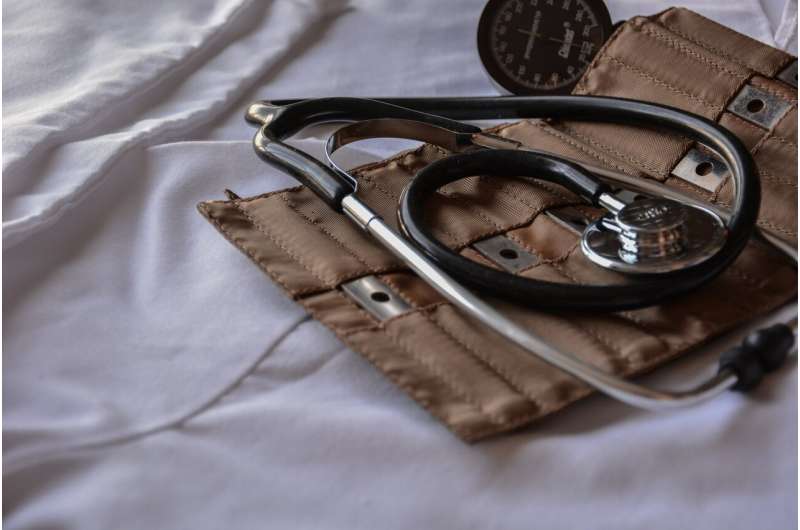Credit: Unsplash/CC0 Public Domain
As the U.S. rides the fourth wave of the COVID-19 pandemic, healthcare providers around the country are striving to save the lives of thousands of hospitalized patients. But as the long-term consequences of these hospital stays become more apparent, with many surviving patients facing so-called long-COVID and continued physical and mental challenges, U-M researchers are examining interventions that can help patients after they leave the hospital.
Much of this work is based on intense efforts to improve outcomes from sepsis, a life-threatening organ dysfunction that results from the body's response to severe infection. Even before the coronavirus pandemic, sepsis hospitalized millions of patients each year, with a high rate of death for those affected and high rates of hospital readmission for those who survived.
With COVID now a leading cause of sepsis, Hallie Prescott, M.D., M.Sc., associate professor in the Division of Pulmonary Diseases and Critical Care Medicine and the VA Center for Clinical Management Research, and her colleagues turned their sepsis research toward care practices for this growing population.
"One of the things that frequently comes up in my work with sepsis is that patients feel, suddenly, all on their own after leaving the ICU and the hospital," said Prescott. In a new paper in the Journal of General Internal Medicine, this perception appears to be borne out in some instances.
With support from Blue Cross Blue Shield of Michigan, the Michigan Public Health Institute and the Michigan Department of Health & Human Services, the team looked at rates of referral to post-hospital follow-up care for nearly 1900 patients during the first and second waves of the pandemic in Michigan.
During the first wave in early 2020, scheduling of follow-up care was rare, with only about 11 percent of surviving patients scheduled at the time of hospital discharge for a primary care follow-up appointment within the next 30 days. Said Prescott, "This kind of made sense, as everyone was struggling."
During the second wave, still only a quarter of patients were scheduled for primary care follow-up prior to discharge. Furthermore, rates of scheduled follow-up varied wildly across hospitals. "At one hospital, all but one of the patients was scheduled for follow-up within two weeks of discharge while in other hospitals, it was consistently zero patients," said Prescott. Overall, around 70 percent of patients ended up seeing a primary care provider within 30 days of discharge. However, those who had an appointment scheduled before being discharged were more likely to have seen their primary care provider within two weeks.
"When I present these findings to physicians, I sometimes get pushback such as 'how am I supposed to schedule their follow-up appointment? Their primary care doctor is not in our system…our system is so fragmented, I can't help," said Prescott. "My response is to put yourselves in the patient's shoes. Our medical system is complex, and often patients need our help navigating it."
Outpatient care provides the opportunity to screen for new physical, emotional, and cognitive impairments common among patients with COVID and sepsis, added Prescott. She suggests that even if you can't make an appointment for the patient, clinicians can help council and empower patients about how and when to seek ongoing care.
"Instead of boilerplate language in a discharge summary, physicians can do a better job of reinforcing the importance of follow-up appointments," said Prescott. This support is important not just for patients, but for their caregivers as well, who may not have been able to be in the hospital with their loved ones due to COVID infection risk.
Last year, she and a team with U-M's Institute for Social Research, School of Nursing and others developed customizable guidelines for COVID caregivers faced with helping people who are recovering following hospitalization.
Prescott, along with colleague Theodore Jack Iwashyna, M.D., and their collaborators have been instrumental in raising the profile of long-term outcomes for sepsis patients. That work is reflected in new guidelines from the international Surviving Sepsis Campaign released this week.
These guidelines, released every four years, have traditionally focused on best practices for life-saving patient care after the immediate diagnosis of sepsis. For this first time, they now include recommendations for improving long-term outcomes.
More information: Hallie Prescott et al, Variation in scheduling and receipt of primary care follow-up after hospitalization for COVID-19 in Michigan, Journal of General Internal Medicine (2021). DOI: 10.1007%2Fs11606-021-07116-6
Journal information: Journal of General Internal Medicine
Provided by University of Michigan























